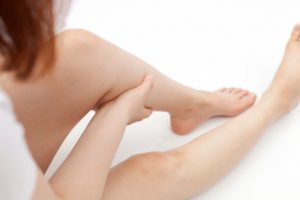 Leg cramps are involuntary and sudden muscle contractions, which can occur any time of the day and can induce extreme calf muscle pain. The good news is, leg cramps and calf muscle pains are generally harmless, but can lead to temporary malfunction of the affected area.
Leg cramps are involuntary and sudden muscle contractions, which can occur any time of the day and can induce extreme calf muscle pain. The good news is, leg cramps and calf muscle pains are generally harmless, but can lead to temporary malfunction of the affected area.
There are numerous reasons why one may experience a leg cramp, from exercise to medications even, so uncovering your underlying cause can help with better prevention and treatment if it occurs.
Advertisement
Here we will explain to you the common causes of leg cramps and share some preventative tips and home remedies you can utilize so you’re not stuck in pain.
What Causes Leg Cramps?
As mentioned, the causes of leg cramps can vary greatly. Some of the most common causes are dehydration, staying in one position for a prolonged period of time, or muscle strain. Leg cramps can also be a sign of an underlying medical condition, such as inadequate blood supply (which can be caused by atherosclerosis), nerve compression such as lumbar stenosis, and mineral depletion including a deficiency in potassium, magnesium, or calcium.
Medications – such as diuretics, oral contraceptives, and steroids – can increase the risk of leg cramps, too.
Some risk factors that increase the likelihood of experiencing leg cramps include older age, pregnancy, taking certain medications, and being dehydrated.
Leg Cramps at Night
Experiencing leg cramps at night is quite common, but it can be a sudden rude awakening. Risk factors for leg cramps at night are similar to leg cramps in general – the only difference is, these leg cramps are experienced during sleep time and rarely in the daytime.
Other causes of leg cramps at night include alcoholism, Parkinson’s disease, neuromuscular disorders, structural disorders like flat feet, endocrine disorders – for example, diabetes, and certain medications such as diuretics.
Leg Cramps during Pregnancy
 The reason why pregnancy increases the risk of leg cramps is still not fully understood, but some theories suggest that fatigue from carrying extra weight, compression of blood vessels, and even a person’s diet may all be viable reasons.
The reason why pregnancy increases the risk of leg cramps is still not fully understood, but some theories suggest that fatigue from carrying extra weight, compression of blood vessels, and even a person’s diet may all be viable reasons.
Leg cramps in pregnancy can occur any time throughout the day, but may feel worse during the night. Night leg cramps during pregnancy can be worse due to peaking levels of fatigue and fluid accumulation.
Leg cramps are most commonly experienced during the second trimester of pregnancy.
Ways to Prevent Leg Cramps during Pregnancy
Some ways to prevent leg cramps in pregnancy are partaking in stretching exercises, alternating between activity and rest, wearing support hosiery, drinking plenty of fluids, wearing proper footwear, staying active, and eating well-balanced meals to ensure you’re obtaining enough nutrients to prevent deficiency.
If a leg cramp does occur, try to straighten your leg and flex your ankle towards your shin, stand on a cold surface – tiled floor, for example, apply a heat pack, and try a prenatal massage.
Leg Cramps Treatment and Exercises
 Mode of treatment for your leg cramps depends on the underlying cause of your condition. For example, you may have to consume more fluids, switch medication, or treat an artery or nerve problem.
Mode of treatment for your leg cramps depends on the underlying cause of your condition. For example, you may have to consume more fluids, switch medication, or treat an artery or nerve problem.
Exercise can be an efficient way to treat leg cramps. The best are the exercises to be carried out during the cramp to stop it and relieve pain, as well as the exercises you perform regularly to reduce the risk of a leg cramp.
If you are in the middle of a leg cramp, straighten your leg and lift your foot upwards, bending at the ankle. Another exercise you can do is walk around for a few minutes on your heels.
And here’s a good exercise to prevent leg cramps. Standing away from a wall facing it, lean forward with arms outstretched and hands pressed against the wall. The soles of your feet should be flat on the floor and you should feel a gentle stretch in your calves. Hold this position for a few seconds and release. Repeat a few times.
All types of stretching can help to relax muscle fibers. After working out, a good stretching routine can help to relax muscles and prevent future cramps. It is also important to build up your exercise routine and try to avoid a sudden increase in activity.
A well-known remedy that works well for leg cramps is acupressure. This involves applying pressure to associated trigger points as soon as the muscle starts to cramp. Pressure should be maintained until the cramp passes. To achieve acupressure, apply pressure to the site of the cramp, pressing your thumbs gently into the center of the muscle for two to three minutes. Gradually increase pressure to counteract the cramp and help to relax the muscle. After the cramp subsides, continue to apply pressure at the center of the muscle for a couple of minutes.
Leg Cramps Home Remedy
Along with regular exercises, there are many other home remedies for leg cramps. These include stretches and massages, hot and cold application, regular hydration, and proper footwear. Speak to your doctor about any vitamin or mineral deficiencies you may be experiencing.
Hot and cold application is one of the most common home remedies for leg cramps. Heat can help to relax the muscle fibers when they start to cramp, and cold may be helpful when the cramp has passed. For heat, wrap an electric heating pad in a pillowcase and apply it to the cramping muscle for as long as the cramp persists. To apply ice, use an ice pack or wrap a washcloth around a handful of ice cubes and apply to the site of the cramping muscle while keeping the leg rested and elevated.
Many people overlook hydration as it may take a little longer to ease the pain, but this is the best way to prevent another cramp in the future. Be sure to drink plenty of water or sports drinks with electrolytes especially when being physically active.
Advertisement
If you have ever experienced extreme tension in a leg muscle, you know how painful a leg cramp can be.
However, although leg cramps can be a pain, they aren’t a serious condition on their own. The contractions which occur involuntarily in muscles are common and generally harmless. Preventative methods that we have discussed can help to reduce the risk of leg cramps and avoid the pain that they bring. Be sure to use the tried-and-tested home remedies for any painful attacks, and also to prevent any future leg cramps.
Also read:
- Leg cramps at night causes, remedies, difference from restless leg syndrome
- Restless leg syndrome in men raises early death risk
